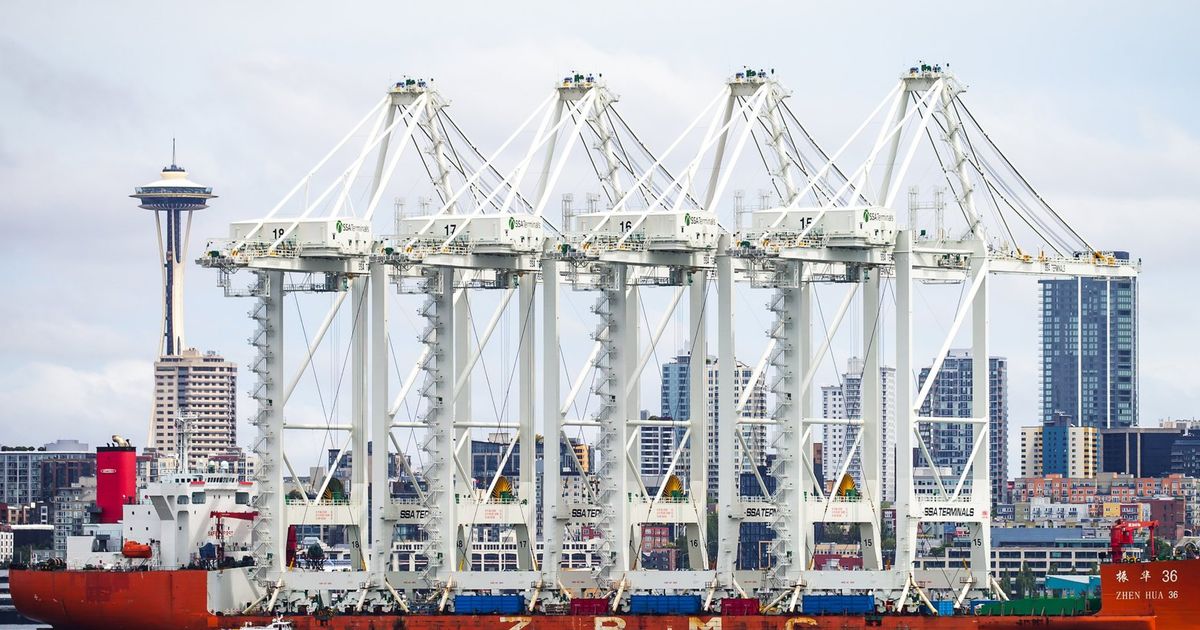Supply chain crisis offers opportunity for Seattle
[ad_1]
If you aren’t looking on purpose, the modern global supply chain is usually invisible. A complex system of materials, craftsmanship and transportation that can just as easily be magical. Wave a wand – or hit that one-click control button – and the world is at your doorstep, sometimes overnight.
The pandemic has turned this system upside down, leading to a breakdown that manifests itself in a number of ways, including empty shelves at the grocery store, school team uniforms not delivered until after the playoffs, and even new unused cars. at the factory, missing the necessary components.
The supply chain is now as visible as the dozen container ships anchored in Puget Sound last week, waiting for terminal space to unload their cargo, or the stacks of shipping containers – some loaded with cargo – pile up in the ports of Tacoma and Seattle.
With the holiday season approaching, things should get worse before they get better. But these short-term challenges can lead to long-term opportunities for the region.
A waterfall effect
Initially, the spread of COVID-19 raised fears of an economic slowdown. As the demand for services collapsed as people squatted down, the demand for products online exploded as more and more people ordered.
Every link in the supply chain is grappling with this demand, resulting in delays and rising consumer prices.
Containers, a pillar of international trade as they circulate around the world, are rare in Asia, which has led to a massive increase in prices. Before COVID, a container moved from China to the West Coast cost less than $ 2,000 to rent. Today, it can cost up to $ 20,000 per container, said Jonathan Song, senior vice president of global sales and marketing at Seattle-based logistics company Expeditors.
There are also bottlenecks throughout the supply chain, with congestion in ports giving way to crowded rail tracks and overwhelmed warehouses, all exacerbated by the long shortage of trucks and drivers.
“I’d be tempted to say it’s a perfect storm, but I think it’s more than that,” said Debra Glassman, professor of commerce at the University of Washington. “It’s that cascading effect of having a system designed with multiple points of failure. “
Build resilience
Supply chain professionals always anticipate disruptions, but these are usually natural disasters such as hurricanes or geopolitical tensions around trade. The widespread stress test of the system presented by the pandemic took everyone by surprise. This has led not only to adapting to what is happening now, the experts said, but also to rethinking what the supply chain will look like in the future.
“The past 18 months have been nothing less than a rewrite of a new logistics playbook,†said Adam Drouhard, general manager of freight at Alaska Airlines.
The goal of minimizing costs by moving materials just before they are needed for manufacturing and keeping inventory minimal has proven unsustainable during the pandemic. And the wisdom of concentrating the manufacturing of certain products in a single region is also questioned.
By looking for ways to make the supply chain more resilient, the Puget Sound region can capitalize on growth opportunities. The region’s ocean freight operations already support more than 58,000 jobs and $ 12.4 billion in economic activity in Washington state.
The Northwest Seaport Alliance, which includes the ports of Seattle and Tacoma, continues to record record volumes this year and is working with terminal operators and the International Longshore Workers Union to improve efficiency.
Congestion in Californian and Canadian ports has allowed the less congested from the Port of Seattle to acquire more business. The January opening of the redeveloped Terminal 5, which will be able to accommodate the largest container ships, will help reduce some of the local backlog, officials said.
This capacity building takes time and underlines the importance of supporting the necessary investments from the private and public sectors.
It is also essential to elect candidates to the Seattle Port Commission – as well as the Seattle City Council – who recognize the port’s value will protect its industrial lands and avoid unnecessary politicization, such as getting tangled up in the recent standoff. which temporarily prevented an Israel-based shipping company from unloading its cargo after activists called for a boycott. The Editorial Board is researching and interviewing candidates and will publish recommendations soon.
Supply chain challenges will continue until 2022, experts said, but competent port management and support from the region’s leaders will enable them to emerge from this crisis and improve the region’s competitiveness. .
[ad_2]

